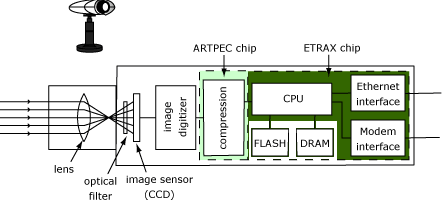
|
 |
||||||||||||||||||||||||||||||||||||||||||||||||||||||||||||||||||||||||||||||||||||||||||||||||||||||||||||||||||||||||
|
|||||||||||||||||||||||||||||||||||||||||||||||||||||||||||||||||||||||||||||||||||||||||||||||||||||||||||||||||||||||||
|
A network camera can be described as a camera and computer combined into one unit. It connects directly to the network as any other network device. A network camera has its own IP address and built-in computing functions to handle network communication. Everything
needed for viewing images over the network is built into the unit.
A network camera has built-in software for a Web server, FTP server,
FTP client and e-mail client. Other features include alarm input
and relay output functions. More advanced network cameras can
also be equipped with many other value-added options such as motion
detection and an analog video output. The components
The network camera's camera component captures the image -- which can be described as light of different wavelengths -- and transforms it into electrical signals. These signals are then converted from analog to digital format and transferred into the computer function where the image is compressed and sent out over the network. The lens of the camera focuses the image onto the image sensor (CCD). Before reaching the image sensor, the images pass through the optical filter, which removes any infrared light so that the "correct" colors will be displayed. The image sensor converts the image, which is composed of light information, into electrical signals. These electrical, digital signals are now in a format that can be compressed and transferred over networks. The ARTPEC processor chip performs such camera controller functions as managing the exposure (light level of image), white balance (adjusts the color levels), image sharpness and other aspects of image quality. ARTPEC also includes a video compression component, which compresses the digital image into an image containing less data for efficient transfer over the network. The camera's Ethernet connection is enabled by the ETRAX chip -- an optimized system-on-chip solution for connecting peripherals to the network. The ETRAX includes a 32-bit CPU, 10/100 MBit Ethernet connectivity, advanced Direct Memory Access (DMA) functionality and a wide range of I/O interfaces. The CPU, Flash memory and DRAM memory represent the "brains" or computing functions of the camera and are designed specifically for network applications. Together, they handle the communication with the network and the Web server.
<< back |
||||||||||||||||||||||||||||||||||||||||||||||||||||||||||||||||||||||||||||||||||||||||||||||||||||||||||||||||||||||||
